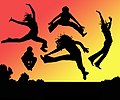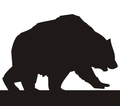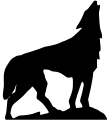Difference between revisions of "AY Honors/Glass Painting/Answer Key"
| Line 25: | Line 25: | ||
The term has been extended to describe the sight or image of a person, object or scene that is backlit, and appears dark against a lighter background. | The term has been extended to describe the sight or image of a person, object or scene that is backlit, and appears dark against a lighter background. | ||
| − | To make a silhouette on glass, | + | To make a silhouette on glass, it is easiest to start with a picture frame. Place a reverse-image pattern behind the glass and color it with opaque black paint on the reverse side of the glass. Allow this to dry, and then (if desired) paint a background over the silhouette using colors. As long as the original layer of black paint is dry, it will not be affected by the background you lay over it. The finished product should be viewed from the front. |
The background is not necessary, or it can be a printed design on a piece of stock card or paper that lies behind the glass in a frame. The silhouette can be the main feature of the piece, or it can be an accent if placed off to the side, in a corner, or along an edge of the glass. | The background is not necessary, or it can be a printed design on a piece of stock card or paper that lies behind the glass in a frame. The silhouette can be the main feature of the piece, or it can be an accent if placed off to the side, in a corner, or along an edge of the glass. | ||
Revision as of 04:19, 15 December 2009
1. Know the primary colors, the secondary colors, and how to mix the primary colors to obtain the secondary colors.
Red, Blue and Yellow are the primary colors. Green, Violet, and Orange are the secondary colors. Red and Blue make Violet. Blue and Yellow make Green. Red and Yellow make Orange.
| Mix this | and this | To make | ||
|---|---|---|---|---|
| Yellow | + | Red | = | Orange |
| Blue | + | Yellow | = | Green |
| Red | + | Blue | = | Purple |
2. Know the materials used in painting, mounting, and hanging a glass painting.
- Glass
- Paint
- transparent paints - allow light to pass through them
- opaque paints - achieve the desired color, but are not transparent
- Other mediums for frosted, iridescent, or crackling effects
- Paint brush
- Sponges - can be used instead of or in addition to paint brushes. Good if you want to paint the entire surface a single color.
- Rubbing alcohol - for cleaning the glass before painting. Don't paint dirty glass!
- Paper towel - also for cleaning.
- Sticky stencils (optional)
- Patterns - can be placed on the inside of a glass and then the design can be copied (similar to tracing).
3. Make and display a glass painting for each of the following designs: animal, flower, and landscape or seascape.
4. Make a silhouette painting and mount for hanging.
A silhouette is a view of an object or scene consisting of the outline and a featureless interior, with the silhouetted object usually being black. The term was initially applied in the 18th century to portraits or other pictorial representations cut from thin black card.
The term has been extended to describe the sight or image of a person, object or scene that is backlit, and appears dark against a lighter background.
To make a silhouette on glass, it is easiest to start with a picture frame. Place a reverse-image pattern behind the glass and color it with opaque black paint on the reverse side of the glass. Allow this to dry, and then (if desired) paint a background over the silhouette using colors. As long as the original layer of black paint is dry, it will not be affected by the background you lay over it. The finished product should be viewed from the front.
The background is not necessary, or it can be a printed design on a piece of stock card or paper that lies behind the glass in a frame. The silhouette can be the main feature of the piece, or it can be an accent if placed off to the side, in a corner, or along an edge of the glass.
Here is a small gallery of images to give you a few ideas:
5. Make a hand-painted mirror picture by removing the back coating of the mirror from the picture area and painting the design on the back of the mirror glass.
Decide where on the mirror you would like to paint the design. Do you want it in the center? In a corner? Once you decided, flip the mirror over and use masking tape to mask around the area you wish to paint. Remember that this is a reverse-image, so if you wanted your picture to appear on the right, you will have to mark the area on the left. Once the area is masked, apply some paint stripper to the area within the tape. Read and follow the directions for the paint stripper. It will tell you how long to let it set before scraping. It will also tell you what kind of gloves you will need to protect your skin.
Once the paint stripper has done its work, you should be able to scrape most of the paint off and rinse the mirror. If you can't get it all scraped off, use steel wool to get that last little bit.
With the mirror backing removed, you should now have a transparent area in which to paint your picture.
Reverse painting on glass is an art form consisting of applying paint to a piece of glass and then viewing the image by turning the glass over and looking through the glass at the image.
This art form has been around for many years. A number of clock faces were created using this technique in the early to mid 1800s, but it started to become popular again in the late 1990s. The painting can be realistic or painting. Realistic reverse paintings are more challenging to create as one must, for example, in painting a face, to put the pupil of an eye on the glass before the iris, exactly the opposite of normal painting. If this is neglected the artist will not be able to correct the error as he will not get in between the glass and the paint already applied. No such care need be taken with the abstract form, but with this form you do not have a good idea what the piece will look like until you are finished painting it. This process is not like stained or leaded glass work in that it is not intended to hang in a window with light coming through the piece. Hanging on a wall, framed or unframed, with a lot of light directed towards the piece provides best viewing.
References
some links for (me) for further reading before putting answers above.
(references for further research)
- http://www.diynetwork.com/diy/gl_other/article/0,2025,DIY_13839_2273904,00.html
- http://www.osv.org/kids/crafts3.htm
(reverse painted mirror)
(hang glass)
(some history from wikipedia)







